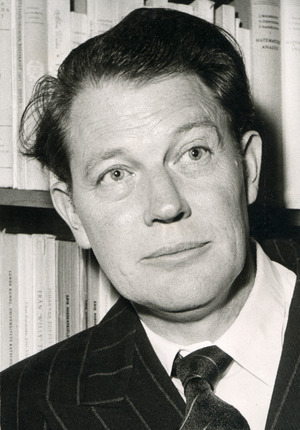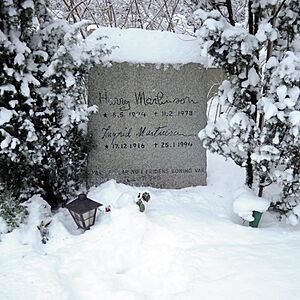Harry Martinson facts for kids
Quick facts for kids
Harry Martinson
|
|
|---|---|

Harry Martinson
|
|
| Born | 6 May 1904 Jämshög, Sweden |
| Died | 11 February 1978 (aged 73) Stockholm, Sweden |
| Notable awards | Nobel Prize in Literature 1974 (shared with Eyvind Johnson) |
| Spouses | Moa Martinson (1929–1940) Ingrid Lindcrantz (1942–1978) |
Harry Martinson (born 6 May 1904 – died 11 February 1978) was a famous Swedish writer and poet. He was also a former sailor. In 1949, he became a member of the Swedish Academy, a special group that helps choose the Nobel Prize winners.
In 1974, he won the Nobel Prize in Literature. He shared the award with another Swedish writer, Eyvind Johnson. They won for their "writings that catch the dewdrop and reflect the cosmos." This means their writing beautifully described nature and also explored big ideas about the universe. Harry Martinson is often called a "great reformer" of Swedish poetry from the 1900s. He was also known as one of the most original "proletarian" writers, meaning he wrote about the lives of ordinary working people.
Contents
Harry Martinson's Life Story
Martinson was born in Jämshög, a place in south-eastern Sweden. He had a tough start to life. When he was young, he lost both his parents. His father died in 1910, and a year later, his mother moved to America.
After his mother left, Harry became a foster child. This meant he was placed with different families in the Swedish countryside. When he was sixteen, he ran away from home. He found work on a ship and spent the next few years sailing all over the world. He visited many countries, including Brazil and India.
After a few years, he had lung problems, which meant he could no longer be a sailor. He returned to Sweden and traveled around without a steady job. Sometimes, he lived as a vagabond, meaning he had no home and wandered from place to place. When he was 21, he was even arrested for vagrancy in a park in Lund.
In 1929, Harry Martinson published his first poems. He was part of a group of five young writers who created a book called Fem unga (Five Youths). This book brought a new style of writing, called modernism, to Sweden. His poems used words in new and interesting ways and often used metaphors (comparisons). They showed his sharp eye for nature and his deep care for people.
He became very popular with his novel Nässlorna blomma (Flowering Nettle) in 1935. This book was partly about his own difficult childhood in the countryside. It has been translated into more than thirty languages. Another very successful novel was Vägen till Klockrike (The Road to Klockrike), published in 1948. Because of his success, Martinson became the first writer from a working-class background to join the Swedish Academy in 1949.
One of his most famous works is a long poem called Aniara. It tells the story of a spaceship named Aniara that gets lost in space and floats endlessly without a destination. The book came out in 1956. It was later turned into an opera in 1959 by Karl-Birger Blomdahl. People have described Aniara as an "epic story of man's fragility and folly," meaning it explores how easily humans can make mistakes and how delicate life can be.
From 1929 to 1940, Harry Martinson was married to the novelist Moa Martinson. She was also a well-known writer who focused on women's rights and working-class stories. They met through a newspaper in Stockholm. They divorced because they had different ideas about politics and life. In 1942, Harry married Ingrid Lindcrantz.
Harry Martinson's Writing Style
Harry Martinson's first book of poems, Spökskepp (Ghost Ship), came out in 1929. Most of the poems in it were about the ocean and life as a sailor. In the same year, he helped create the important book Fem unga, which was a big step for modern writing in Sweden. His major breakthrough was his 1931 poetry book Nomad. His poems were known for their rich descriptions and careful observations of small details.
In his books Resor utan mål (Aimless Journeys, 1932) and Kap Farväl! (Cape Farewell, 1933), Martinson shared memories from his time as a sailor. In his later works, nature and the Earth became very important topics. During the 1930s, he became a master at describing nature in both his stories and poems. He was especially famous for his short nature poems that showed very precise observations.
In his autobiographical novels, Nässlorna blomma (Flowering Nettle, 1935) and Vägen ut (The Way Out, 1936), Martinson wrote about his childhood. He was also very interested in science, and this influenced his writing. In his book Verklighet till döds (Reality to Death, 1940), written during World War II, Martinson criticized society and how technology was developing. This criticism of modern life also appeared in his philosophical novel Vägen till Klockrike (The Road, 1948) and his poetry collection Passad (1945).
In his later writing, Martinson started exploring a new big theme: his growing interest in outer space and the universe. This was most clearly seen in Aniara (1956), his famous space epic. In his very last works, his criticism of modern life and technology became even stronger. This was clear in his 1960 poetry book Vagnen (The Wagon). This book was not well-received by critics at the time. Because he was sensitive to criticism, it seemed like it would be his last book of poems. However, in 1971, he returned with Dikter om ljus och mörker (Poems of Light and Darkness). This was followed by a collection of nature poems called Tuvor (Tufts) in 1973.
Harry Martinson's Legacy
Many people consider Harry Martinson to be one of the greatest Swedish authors since August Strindberg. In 2004, Sweden celebrated the 100th anniversary of Martinson's birth with events across the country.
Several awards and groups exist to honor his memory:
- The Cikada Prize has been given out since 2004 in his memory.
- The Harry Martinson Society was started in 1984. It gives the Harry Martinson Prize to people or groups who work in a way that reflects Harry Martinson's spirit.
- The Swedish Academy also gives a scholarship in memory of Harry Martinson to a writer who writes in Swedish.
See also
 In Spanish: Harry Martinson para niños
In Spanish: Harry Martinson para niños


